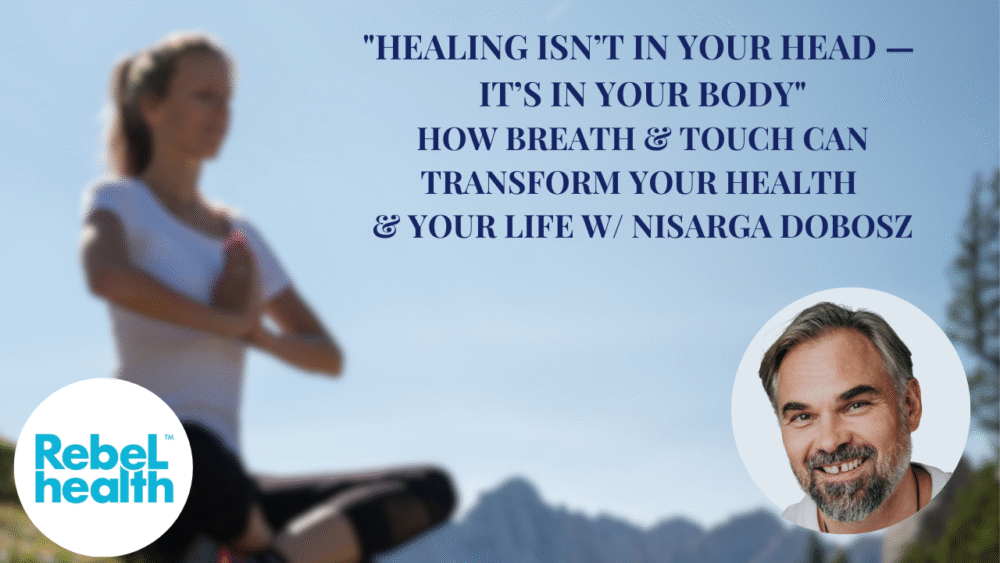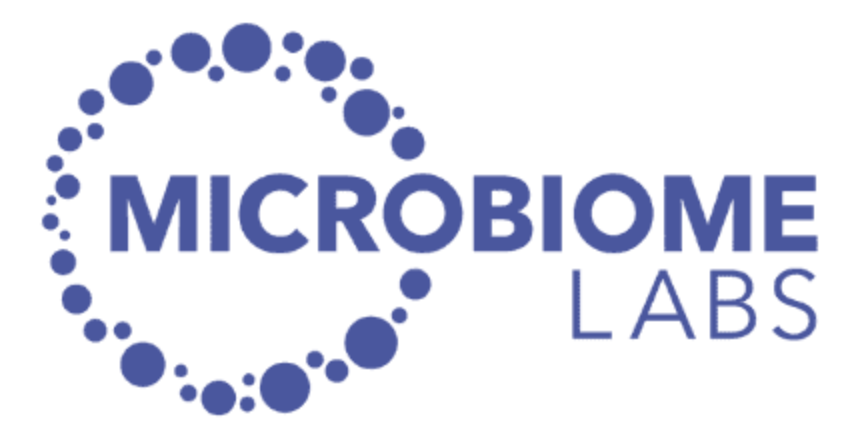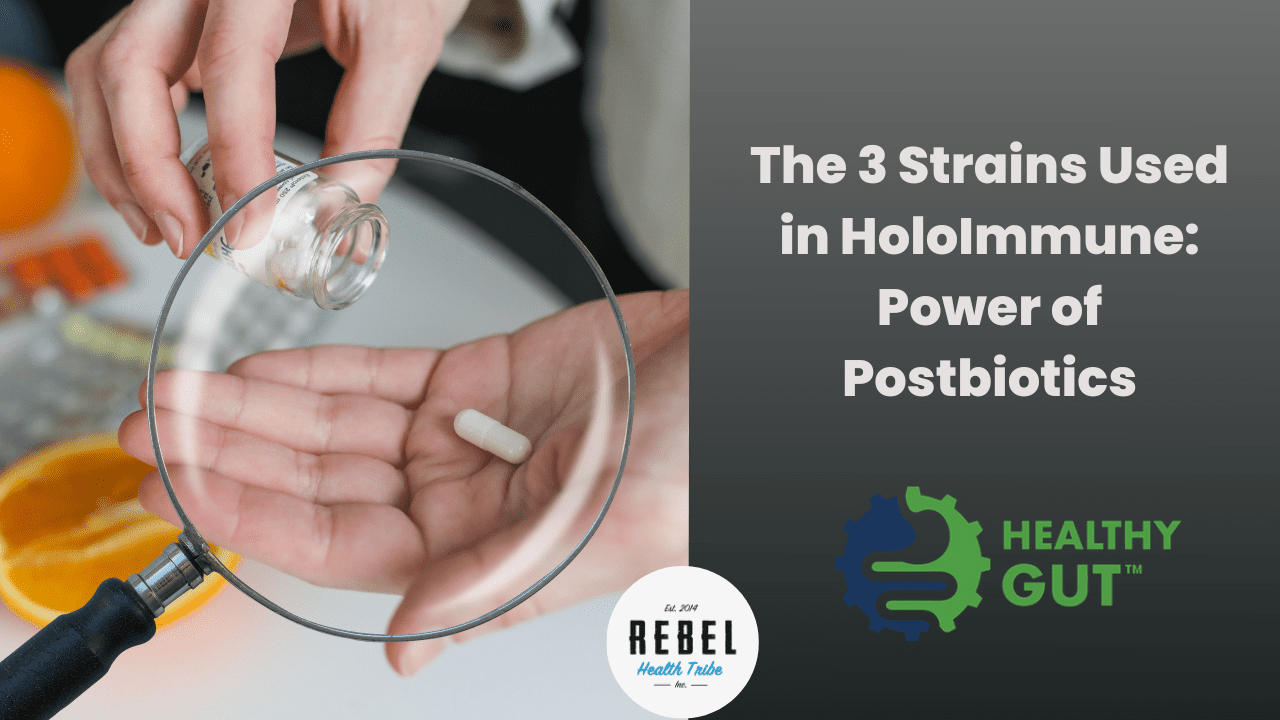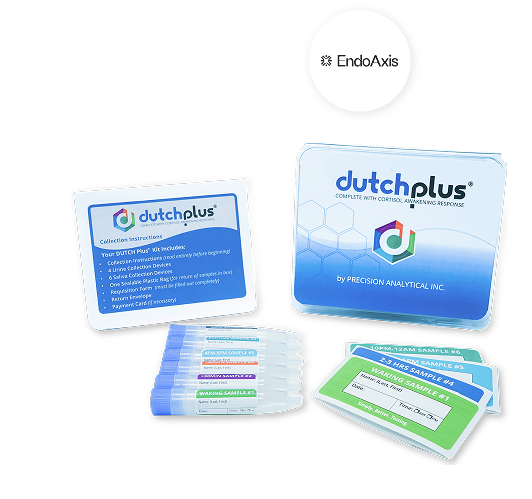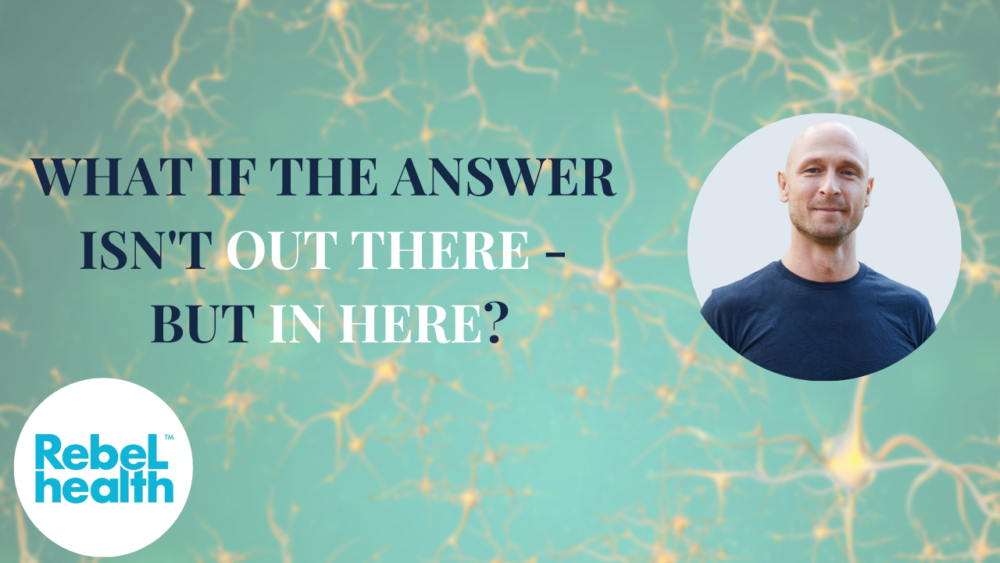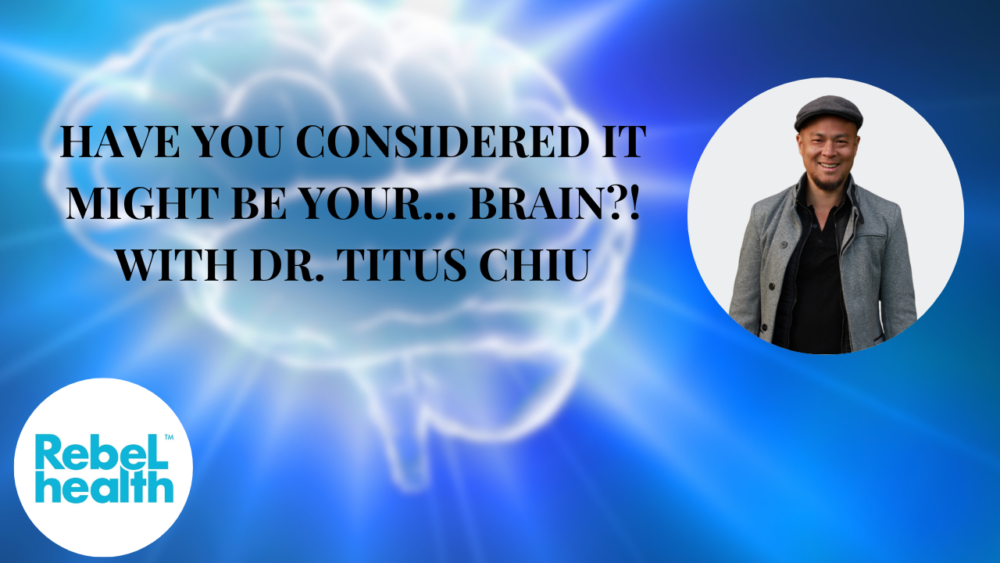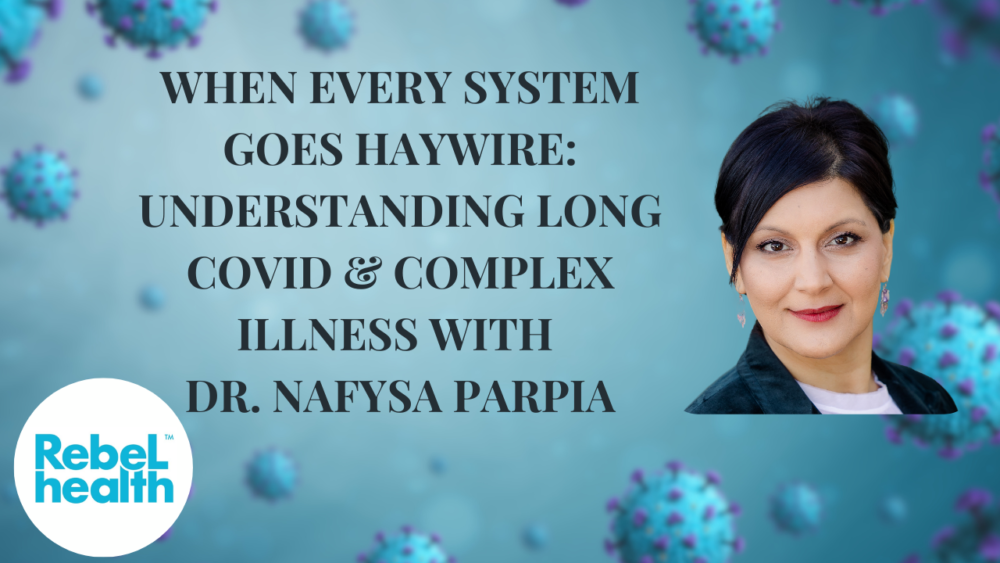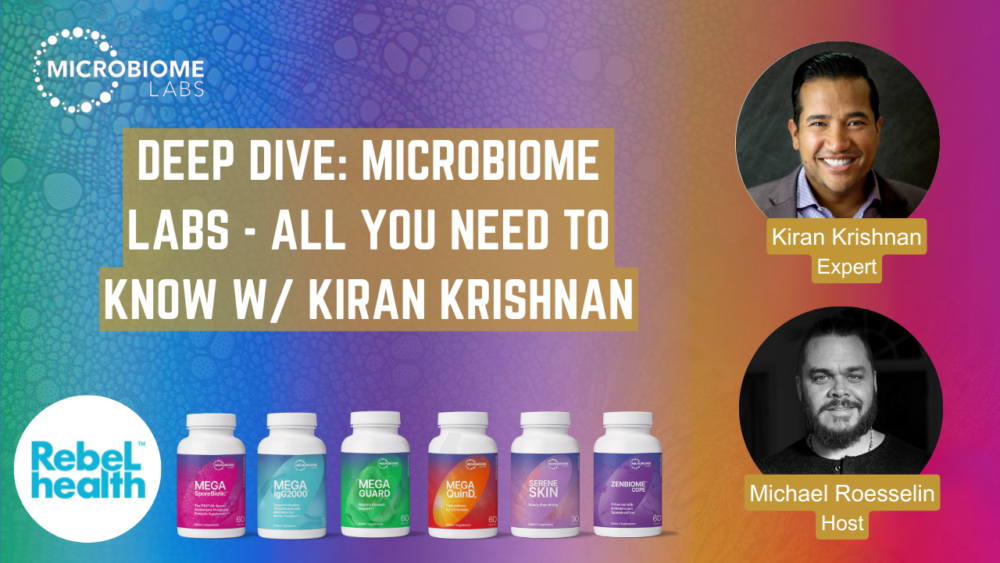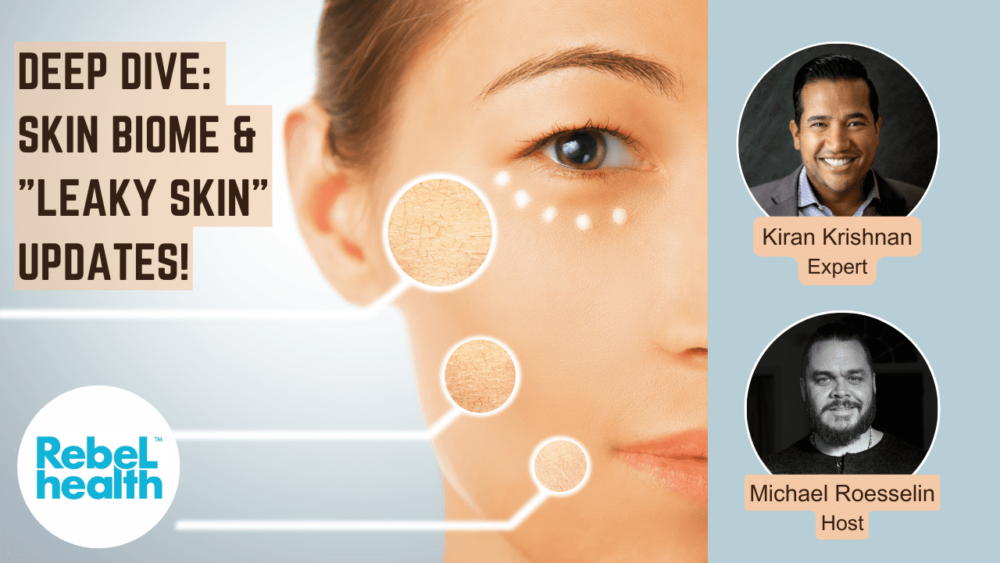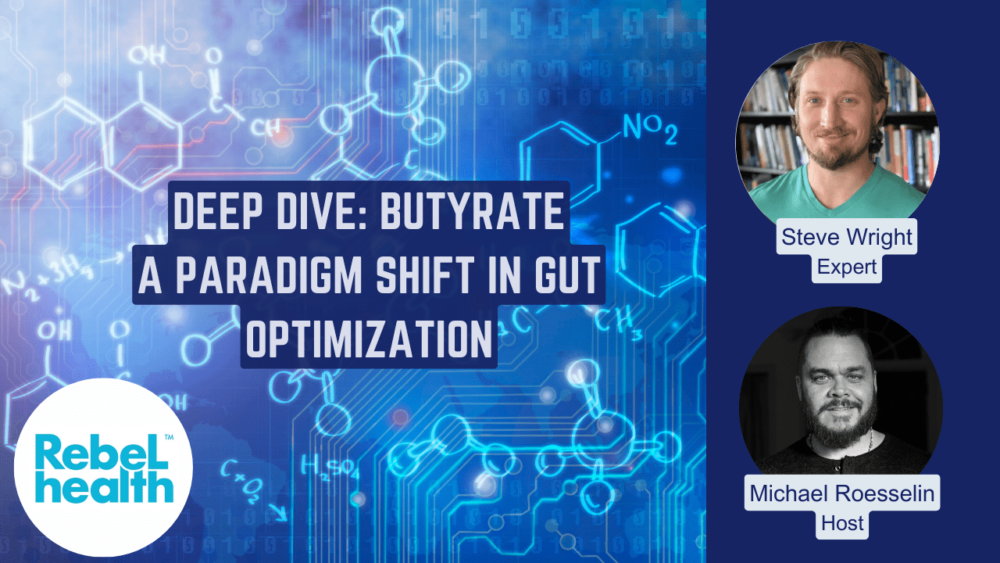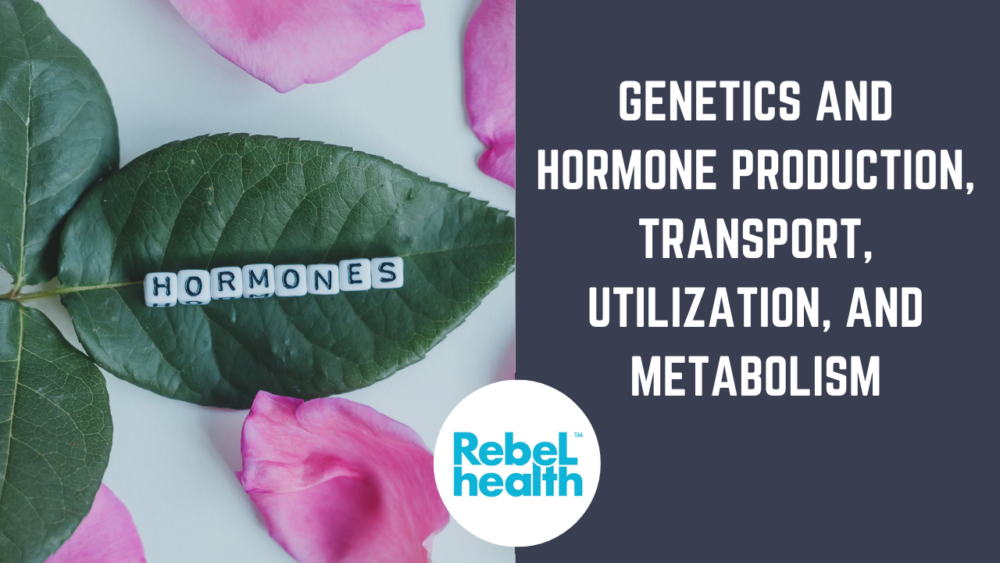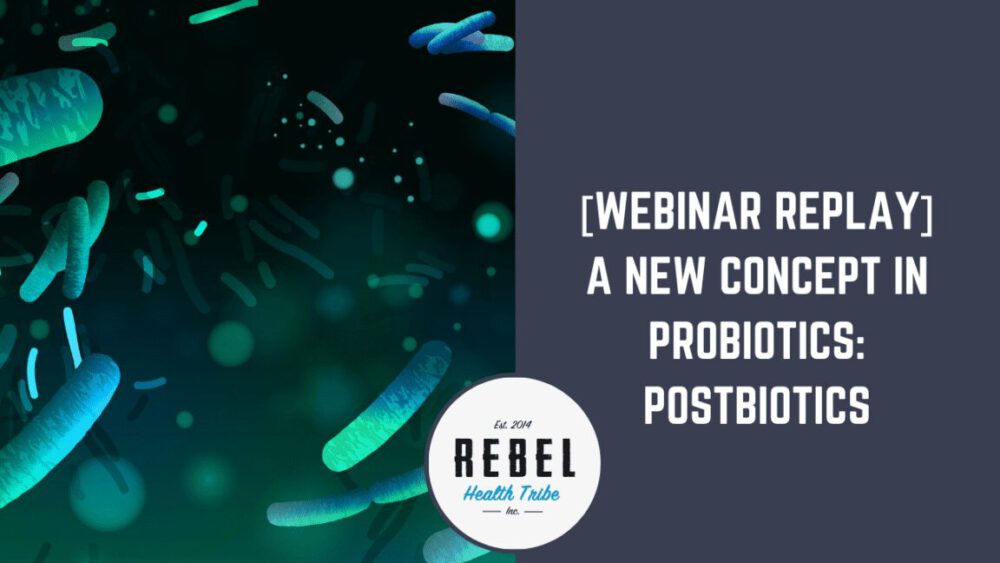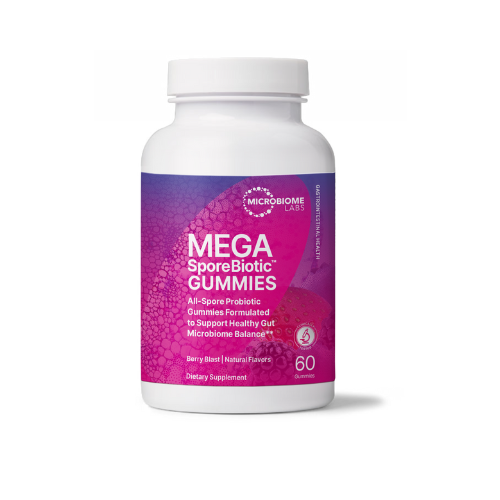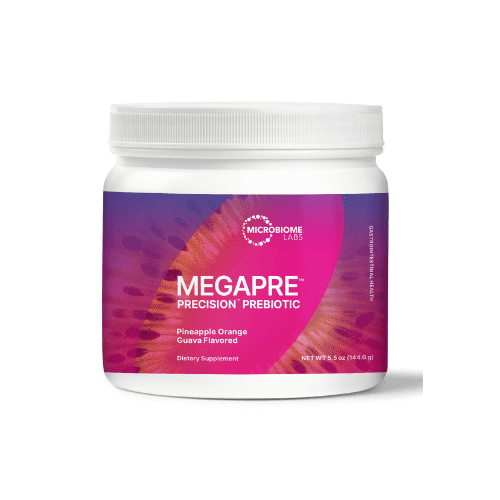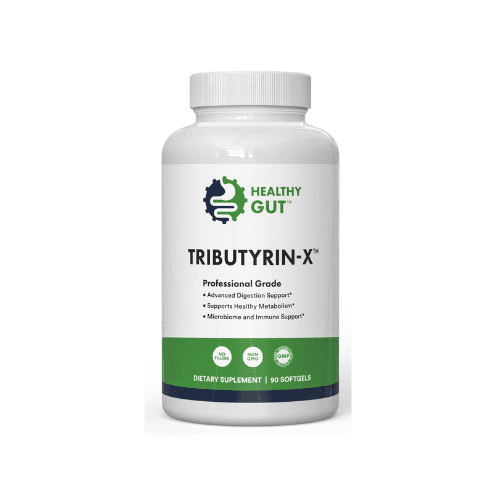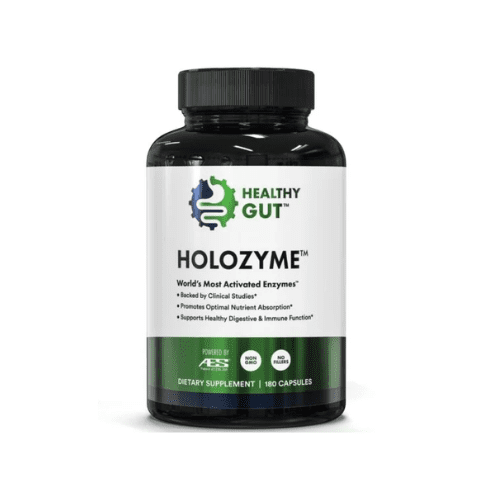[Michael Roesslein]
And we’re live. Hey, everyone. I am recording this special video today for you to learn about allergies and what you can do about them and things that relate to allergies like skin issues and food sensitivities.
And I am here with my friend and gut and health educator and founder of Healthy Gut and overall really brilliant and funny guy, Mr. Steve. Right, Steve? Hello.
Hello, Michael. It’s a great shirt you got there. Thanks, man.
All right. We’re going to, it’s April when we’re recording this. So it’s mid April.
I don’t want to jinx myself. I’m 44. I don’t think it can start now, but maybe it could.
I’m not an allergy sufferer. So I don’t know the exact range of seasonal allergies, but I think we’re in it. I think April in a lot of places, if things are turning green and there’s flowers and there’s those floaty things in the air, which here looked like the other day, I think is you’re in it.
And I witnessed for the first time up close last year, my wife got horrific seasonal allergies, which it took us over a month to even figure out what was going on because she never had them before, but her like eyes were watering. We went on a lot of walks and there was a lot of that. And her eyes were watering, her nose was running.
She started to get red skin face burning, itching all around the eyes, all this stuff. And we tried a bunch of stuff that wasn’t for allergies because we had no idea what the hell was going on. And then one day she’s like, do you think I could just be having allergies?
And I said, I don’t know. Never had allergies before. Looked it up.
Sure enough. Allergies. We threw everything at it.
We possibly could. But I learned that with things like that, once it gets to that point, it’s a lot harder to reverse it than it is to stop that from happening or quell it when it’s smaller. But it really, I’ve heard all my allergies, my allergies, it’s kind of something I always just would hear and it would go like in one ear out the other.
And I was like, whatever, you’re fine. It really sucks. And it’s terrible for tons of people.
And judging by how much of the drugs they sell for allergies, I think it’s quite common. It’s right up there with acid reflux and how many of those drugs they sell, like Claritin and those kinds of things. So before we get into solutions or things about this, when we’re saying allergies, I was just talking about crying eyes and nose and sniffles and skin and whatever, but the same kind of, I’ll call it reaction or chain reaction or events within the immune system are very similar between that kind of allergies, like the stereotypical, if you’re on a TV commercial, sneezing allergies and all that stuff and some other conditions and symptoms, right? Like there’s almost like a cluster of this.
[Steve Wright]
Yeah. So I mean, people with seasonal allergies, there’s also basically like year round allergies as well. It’s like a different category of allergies, but it’s basically not seasonal because you’re reacting to mold or mites or something else in your environment that doesn’t change based on, you know, April and springtime or some sort of nature derived pollen or something.
But those same pathways that get upregulated and then too dominant, it’s usually considered a Th2 dominance inside the immune system. Basically, your immune system has a Th1 branch and a Th2 branch and the Th1 is more autoimmune conditions and Th2, if it gets out of balance, is more these allergic conditions. And those are also associated with food sensitivities, food allergies.
And they’re also associated with eczema, rash, like unexplained rashes that don’t quite fit the rosacea or eczema category as well as different, like there’s a couple of different types of acne and then some types of acne as well. And so you might be wondering like, how does, yeah, how does that all work? And it is extraordinarily complex.
We’ve done some other recordings where we’ve gone deeper in it, but I would say it’s kind of simple if you think about it, like almost like text message or email. It’s like basically your gut and your immune system. Again, your immune system is basically in and surrounding your gut.
The majority of it’s there. That’s where the bulk of the immune system is happening. If your immune system gets tilted out of balance based on what’s happening in your gut, it’s going to be firing out messengers, which we’ve all heard about now called cytokines.
And there’s like so many different pathways here. It’s like, it’s insane, honestly, how many different pathways or feedback loops.
[Michael Roesslein]
The immune system complexity, when I hear people talk about it and it’s full, probably not even its full expression. Like I bet I’ve never even encountered that level of explanation of it before, but as deep as I’ve seen people go with it and some of the trainings I’ve been through and people I’ve interviewed, there is not a health physiology related topic. And I have a master’s in physiology.
I should preface that, that causes me to glaze over. Harder than when someone gets into like cytokines and immune pathways and those kinds of things because of the absolutely absurd complexity of it all. So let’s not do that.
[Steve Wright]
Right. I like to think of it like the immune system is constantly communicating with the rest of the body. So the gut immune system is constantly sending out emails or SMSs to the rest of the body.
Those look like different cytokines or different pathways. It’s going to communicate 24 seven and it could communicate sort of anti-inflammatory pathways or regulatory pathways, or it could communicate inflammatory pathways. And it can kind of get stuck, like stuck in one mode of communicating and one way of going almost like, you know, if you drive home from work and you always take the same route back home from work, you don’t have to think about it because like that’s your way, even though there’s five or 10 other ways to get home.
And some days it might even be better to take a different route. You won’t do it because that’s just the route, you know, and it’s stuck in your brain. Well, the immune system can get stuck in a pathway as well.
And if those pathways are more in this IgE formation in this Th2 Dominus formation, this allergic formation, then you get the expression looking like skin problems for folks who have sort of the underlying weakness in the skin. You know, some people have the immune system weakness around seasonal allergies or year round allergies. And also it can just get sensitized because you’re just being exposed to it every single day, like dust mites or something like that.
And so what we’re hoping to have is an immune system that doesn’t over sensitize to regular things like dust mites or ragweed or tree pollen or grasses or dogs or whatever it might be. Those that’s literally almost harmless stuff in our environment. But sometimes the Th2 system gets aggressive and it tags it as a bad guy with antibodies, IgE antibodies.
And then those things are all over your mast cells, which we’ve talked about in other talks. And now because the whole system is just alerted, it’s like just waiting, like, give me a piece of pollen. I can’t wait to kill that pollen.
As soon as it gets that piece of pollen, boom, histamine, boom, all these other anti-inflammatory and these inflammatory pathways get kicked off. And then you have those, like you said, the breakout of the skin, the itching in the eyes, the gunk in the eyes, the nasal congestion. You can have, you know, food sensitivities kind of run along the same pathway.
It’s just that instead of pollen, it’s like, oh, there’s kale again. I had stuff. We’re going to kill all that kale or beef or corn or whatever it is.
And so what we want is an immune system that doesn’t get excited about killing harmless things that don’t need to be killed. We want an immune system that’s able to differentiate between good and bad and actually potentially bad for us, like actual harmful versus harmless.
[Michael Roesslein]
That was a great quote. We want an immune system that doesn’t get excited about killing things that doesn’t need to be killed. But yeah, I’ve heard this almost explained like a bar fight, like it kills the thing, like it attacks the thing, but it also like damages everything all around it.
And it kills a whole bunch of other things. And it’s not very, this isn’t a super precise or precision type of thing. So then you get, and there’s mimicry, which we want to go even further.
If something looks like a kale, because I’m right with you there, Th2s, I hate kale. So, and this can happen. And you mentioned in the gut.
So the gut immune system is sending these signals. I like the text message reference to the rest of the body. That’s the thing about gut inflammation that I think that a lot of people don’t understand is that there is no local, I mean, there can be local inflammation if you like break your ankle or something.
But even then I would guess your systemic levels of inflammatory cytokines and things are higher if you have a acute injury, because it’s sending those signals like, oh, this is damaged inflammation. And then those signals get in the blood and the blood is everywhere. But in the gut, if the gut immune system is freaking out about food or about something that’s there or the inflammation, like of the gut lining or like dysbiotic bugs or whatever thing.
And it’s sending out these inflammatory signals of freaking out to fight these things. The rest of the parts of the body that have receptors for those kinds of signals who receive those kinds of signals are going to be like, oh no, we’re under attack. There’s this thing.
I need to put up my defenses. And so that’s how like gut inflammation, for example, could contribute to like joint pain or whatever your body’s thing is that kicks in when you get an inflammatory cascade. And so for some people that ends up being hyper-reactivity to it.
[Steve Wright]
Yeah. So my things, right. Right.
We’ve talked in other, other longer form interviews about the five layers of the gut. You know, Karan has spoke at length about various layers of the gut. The immune system is behind those layers.
It’s like the last layer, in my opinion, it shouldn’t be getting that exposed to food particles, like, you know, especially just naturally real food, you know, stuff, um, or pollen or other stuff. Like in general, there should be a buffer. There should be a lot of like, uh, uh, you know, the, like almost like the immune system is kind of like the crown jewels inside the castle.
And there should be like a moat and a wall and an archer and like maybe a dragon. If you’re really rich and cool, like there should be a lot of layers of defense for pollen or kale or corn to get to the immune receptors to really kind of kick this off. Because let’s say those layers are gone or depressed or broken.
Don’t blame your immune. I don’t blame my immune system that when I was my sickest, I had like my, I would wake up in seasonal allergies and I have to put water on my eyes to get them to, they had that yellow gunk on there. I couldn’t even open them.
Um, so at my sickest, my immune system was so wrecked. And I believe that was because the, it was just getting inundated by, by pollen all day long. And if it thinks there’s like, you know, a hundred guys showing up at your house to fight you, it’s going to go on guard.
Right. Versus if only one person shows up per day, you’re like, oh, that’s interesting. That’s just another guy in the neighborhood.
Um, and so I think as the gut breaks down, you get a overexposure to the immune system of harmless particles of any type, including mold at some level. And when the immune system gets over indexed and it seems like there’s an invasion of pollen or an invasion of kale, it’s gonna react because that’s his job. Um, and so what we want to do is we want to kind of soothe the immune system.
We want to obviously want to heal the gut, do everything we can to help the gut. But we also, we can’t just assume this is the biggest myth. I think that hasn’t been busted out there yet is that there’s all over functional medicine, integrative medicine.
There’s this theory or this myth of this untalked about idea that if you just eliminate the root cause, whether it’s mold or infections or gut issues or leaky gut or whatever it is, your immune system just snaps back to, to fine, to good to go. That, that doesn’t happen anywhere in the body. Never do we just snap back after an ankle injury or shoulder injury.
Like you, you have a head injury, you learn how to need to learn how to walk again or something like no other part of the body just normally goes back to, to fine without some sort of rehab process. And I think that’s what we’ve been missing is that the immune system, even if you’ve already eliminated the mold, if you’ve eliminated the leaky gut, if you’re like doing well, but you’re having these seasonal allergies, these rashes, these food sensitivities, it’s likely because the immune system never got its rehab process to help it relax around harmless and just react to harmful.
[Michael Roesslein]
Okay. That makes sense. I have a lot of injuries in my younger days, playing a lot of sports.
And I always had to go to the place that helped me fix them. If you didn’t, it would take forever to heal and it wouldn’t heal how I would want it to heal. So there’s a lot of different ways to do this.
And, and a lot of factors that contribute to it, which you’ve already mentioned a lot of them relating to gut health and like the exposures. And like people think if you eliminate the exposure, then it’s just going to stop freaking out. And that’s these people like, Oh, I was in a mold place.
And then I left the mold place, but I’m still like reactive to everything. And it’s like, cause nobody’s told their body to calm down. And so we’re going to talk about one of the most interesting topics that I’ve gotten lucky enough to interview a lot of people around gut health, around supplements, around probiotics, around ways to deal with these kinds of things.
And I remember the first time I talked to you about this. And then the first time I talked to Kieran about this, and it was like a light bulb went off that this is a thing and how is this a thing? And it was like amazing that it’s a thing.
Cause it doesn’t make any sense to me still. And it doesn’t matter, but we’re going to talk about something called paraprobiotic. And you have a product called hollow immune that you originally created to make it.
So you didn’t, and this is not a medical claim. Please don’t go to the FDA and get our doors busted down. It made it.
So Steve was, uh, didn’t die from COVID. That was the point was to take it around COVID time and he’s here now. So obviously we’re not going to make medical claims.
Um, but originally you got it because the thing around is funny, but like the thing around COVID that when, when, when it was like raging and tons of people were dying was, um, that the, the, the danger from it was like overreactive immune system response. It doesn’t shut off. So you were looking for ways of a thing that you could create that you could make that you could take that would help control the proper immune system, proper immune system response, not an out of control train down the tracks going berserk.
That doesn’t shut off because what I don’t know if every, I think a lot of people learned this because of COVID people learned terms like cytokine storm. And then I had like Bob down the street lecturing me about cytokine storms and I’m like, Oh man. But, um, that was the reason, but then that same ability to in train, the immune system to have a proper response to things you have since seen with your company and your practitioners and your customers who are using the paraprobiotic incredible results with seasonal allergies, with skin rashes, with food sensitivities, with these kinds of things that involve an improper response to a safe thing. So can you just share what the hell am I talking about? What’s a paraprobiotic, um, what is in this, how does it work and what are you seeing?
And I think it’s a great solution for people that I think anyone who’s prone to any of these conditions would benefit from hearing this. So just let them have it. All right.
Yeah.
[Steve Wright]
So, um, yeah, I was fascinated by the fact that the immune conversation hasn’t moved past like echinacea and, uh, vitamin D and elderberry and zinc and see it like, that was like the only thing that was being talked about. And I had known about those things for like 15 years and I’d done like inappropriate doses. Like I’m talking like an entire bottle of elderberry extract when I get like sick and just notice that like if they do help, I chugged stuff.
You’re not alone. Okay. Great.
Great. Um, if it does help, I was already doing inappropriate dosages and it didn’t really seem to like protect me from like the flu or the cold or something. And so it really just got my mind turning about like what else is possible with immune system modulation and what are we missing here?
And so I think that’s where just a lot of anxiety late at night turned into the gut and the immune system. And then it turned into, Holy cow, Japan has been studying these heat killed probiotics for like decades and their data is phenomenal. Like some of the best research data on supplements out there.
Um, and then it didn’t make any sense, right? Cause I, all I’ve heard is that probiotics need to be alive or protected or something like bugs need to be alive to work. How could these dead bugs work?
And I just started, you know, I don’t know if I’m the most well researched on paraprobiotics on the earth. I probably not, but I hope I’m in the top one, 1% or top 0.1% at this moment. Um, and what I’ve learned from reading hundreds of papers on all types of paraprobiotics is that heat killed cells.
These are, these are beneficial cells, uh, that when they’re alive, they’re called a probiotic and they give them to people and they can measure good outcomes and then they kill them and then they give them to people and then they measure different good outcomes. And so if you want good outcomes around like the gut, the gut wall, uh, certain specific things, a lot of times you want a probiotic, but if you want good outcomes in health around the immune system, typically you are only going to get that or the best ones out there to get it from are the dead ones, the paraprobiotics. And that was like, I was like, what is happening?
My worldview is hurting. Um, and it kind of makes sense.
[Michael Roesslein]
Honestly, I don’t want to throw anybody under the bus, so I’m not going to name names, but that, that whole, like my worldview is threatened. I’ve seen far too many people in this industry. Um, that’s a, that’s a, that’s the, they, how do I say this?
Well, they retreat intentionally, then disregard the thing and then keep saying the thing that they just learned was not true because it fits there. I don’t think that’s relative. I don’t think that’s only in the health industry, but, um, no kudos to you for encountering a thing that blew your worldview open and then being like, huh, I’m going to try that thing.
Not, Oh, hi, go. No, this is the way.
[Steve Wright]
Yeah. Well, thank you. Yeah.
I mean, I, when that happens, I think there’s, I get excited sometimes. I mean, it’s really frustrating in the moment, but, um, but what, what it, what happens is that the body, this, this body does not want to take in live bugs. It doesn’t matter if it’s like yeast or fungus, uh, which are basically the same or bacteria or viruses or whatever.
The, the body doesn’t want to take in live stuff because what if that live thing ends up replicating and killing us, but if the material is dead already, it’s much more likely to grab it and sample it and take it in. And so it turns out that the pair of probiotics are accepted because they’re safe. They are absolutely safer than probiotics.
Um, there’s several papers on how, if you’re extraordinarily immunocompromised, some probiotic strains have killed several people. These are very, these are usually bedridden people in hospitals, things like that, not you and I. So don’t get afraid of probiotics.
The point is though, then they give those types of people pair of probiotics and actually see up regulation of immune systems. They see better outcomes in, um, trained immunity, things like that. So, so they’re safer for immunocompromised people, kids, everybody, because they’re just dead.
There’s no chance of them replicating and taking over and hurting anything. And so what this means is the body’s kind of like says, okay, okay, okay. And then this stimulus is just like the stimulus of a broken down gut with too many people showing up at the front door that are pollen or kale.
Now it’s seeing all this new pair of probiotic people showing up. It’s saying, come on in. And then, and then that’s saying, Oh, I’ll, okay, sure.
I’ll, I’ll relax. I’ll, I won’t make as much TH2. I’ll make more T regulatory cells.
I won’t make as much IgE antibodies to regular things. I’ll, I’ll kind of down-regulate those pathways. And so it goes and it starts down.
Each bug, each strain has these very narrow areas in which it down-regulates certain parts of this overactive immune system. And so what that ends up looking like, if you stack a few of them together at the same time is almost like when you’re out of control and you need to like breathe or get underneath a blanket or go meditate or take a walk in nature, you’re down-regulating your system. These bugs, if enough are taken at the same time, what they do is they down-regulate that pathway, that allergic, harmless overreaction to, sorry, an overreaction to the harmless parts of the world.
It down-regulates it on multiple fronts at the same time. And that looks like, you know, the, the crazy amount of reviews and testimonials we have where people are just like, wow, I, you know, I’m finally off Claritin. You know, I, I couldn’t get rid of this rash.
I tried all these topical things. Nothing would get rid of it. I’ve tried all these things for acne.
Nothing would get rid of it. I’m so, I’m so grateful that, you know, I’m finally adding foods back in. I can never add dairy back in.
I’m finally adding dairy back in. And I think a lot of it just has to do with the fact that you’re, you’re essentially backing it or you’re putting input in through these dead cells to the immune system rather. And that, that input is saying, slow down, stop reacting, stop those inflammatory pathways.
And that’s the part of the rehab that there’s nothing else in the world that I’ve ever found. I don’t know of anything else in the world that does this specific job inside the body. And so for me, it really is a rehab of the pathways of the immune system towards balance, towards harmony, such that again, we react to harmful things and we don’t react to harmless.
[Michael Roesslein]
Makes sense. And it’s incredible that it works like it does. I wonder who figured that out?
Like, I wonder if we eat the dead bugs, what will happen and then did it? I’m sure that, you know, or that somebody knows, but that’s just, sometimes I come across things and I’m like, who was the person that thought this was a good idea?
[Steve Wright]
It started in the nineties, frankly, in like 92, early nineties. Um, they just started giving live, they would come up with a bug. They’d say, oh, this is a really good probiotic.
Let’s see what happens. They’d give 30 milligrams or let’s say like 10 billion CFU to 30 people. And then they’d kill it and they’d give the same 10 or 30 billion CFU or whatever to the other people and same dosage.
And then they would measure just like giant blood panel, just like all kinds of markers, everything to see what would happen. And that’s when they started to realize that the dead bugs moved blood markers differently than the live bugs.
[Michael Roesslein]
This is like a whoops.
[Steve Wright]
I think, I think so. I also, obviously live bugs are harder to manufacture, keep, keep, keep around.
[Michael Roesslein]
It’s not all dead bugs. It’s not that you can just randomly throw dead bacteria in a capsule and it has this effect. The strains that he used in holoimmune are very well researched backed and very well studied.
And then there’s also a beta-glucans, which if you want to take a couple of minutes to explain what beta-glucans are and why you included them in the formula, what they do, it gives it like a really well-rounded, really powerful effect.
[Steve Wright]
Yeah. Yeah. So, so beta-glucans are literally like a para yeast biotic, really.
Beta-glucans are dead yeast cells. Now, beta-glucans can also come from mushrooms. They’re, they’re a specific type of molecular structure.
So they can come from mushrooms. They can come from all different types of sources, frankly, but there’s like, oh, barley has like some in it as well. It just turns out that the yeast version, the yeast extract is the most researched out there, like throughout history and has extraordinarily well-documented outcomes for raising secretory IgA.
And secretory IgA, if you’ve been around the gut world or the immune world, you know, it’s like extraordinarily important. It’s like, I don’t know, it’s like the Marines of the gut, like there, you need a lot of it. And it’s very helpful for actually combating dysbiosis.
It’s helpful for any sort of infection that might be happening inside the gut. Like it’s a really important molecule. And it can get extraordinarily depressed in people with chronic health conditions.
There’s just, they just don’t get enough of it. And beta-glucans from yeast, specifically 1316 has extraordinary data on raising it, helping people with athletic performance, helping with allergies as well. So beta-glucans are super slept upon, but they are like one of the reasons why beta-glucans, I think, get so much credibility in the research is because they’re doing a similar thing to the paraprobiotics.
Again, it’s like a para yeast biotic. It’s a specific type of molecule that the immune system uptakes, and then it modulates it in beneficial ways. And you can go down a lot of rabbit holes around everything from cancer, like I said, to athletic performance, just to regular like food sensitivities and allergies for beta-glucans, which are really, they’re really cool things.
[Michael Roesslein]
It’s again, fascinating. The first time, I don’t know, when did you launch this product? Like 2021?
[Steve Wright]
Yeah. Yeah, probably late 2021.
[Michael Roesslein]
Yeah. It was like a while ago. I remember after our first, I didn’t know anything about it.
Like you have a new product? Cool. Let’s do a webinar.
And then that was it. And then I got on the webinar and then I was like, what the hell did I just learn? And then I looked up beta-glucans and there’s some website with some doctor or some guy that’s like the beta-glucan guy.
And I went down a rabbit hole on his website for like three hours one day and was just reading all this stuff about all these different beta-glucans. And if I didn’t know better, maybe I’m wrong and this guy’s right. Like beta-glucans can fix anything according to this website.
And like, there’s these ones that do this and these ones that do this and these ones that do this, but like the amount of studies and research behind it was really impressive. And I think what he does, his business was like, he makes them or grows them or cultivates them or whatever, and then provides like them for different uses for different products for different things. But I was like, how is this a thing?
And how is it so well-researched and known and verified? And I’ve never heard of it before. And I thought I knew all the things.
And then every once in a while something comes along and I’m just like, I don’t know shit. Which is kind of how you felt when you found paraprobiotics was like, because you’d already done all the SCD lifestyle brand, right? When you found paraprobiotics and like how effective like these specific strains are like all of this, um, you’d already been teaching like gut health stuff for.
Yeah. 10 years. Yeah.
[Steve Wright]
So you know, the research started in the 1990s, like it’d been around the whole time. I just didn’t even, I never even heard of it.
[Michael Roesslein]
But like, if you had never heard of it and you made a career out of knowing the things for gut stuff, whoever’s in charge of paraprobiotics PR has not done a good job, but now you’re the paraprobiotics PR. So, um, the product is holoimmune. We’ll, uh, we’ll put information down below this video, but it is like an all-in-one powerhouse for getting your immune system to not freak out is the way that I would, um, be really scientific in how I talk about it.
But what you’ve seen with people is wide ranging benefits when it comes to seasonal allergies, other kinds of allergies, skin issues, skin rashes, food sensitivities, reactions, anything that’s like your body freaking out about stuff. It doesn’t need to freak out about. And I think there’s a lot of people that watch our videos that fit in that category.
[Steve Wright]
Yeah. And, and to your point at the beginning of the show, it’s not an antihistamine, so you can’t just take one pill tomorrow and expect, um, immediate resolution. Uh, it is a, literally taking your immune system to the gym.
And it’s starting with like, you know, two pound weights and it’s going to go up to five pound weights. And by the time you get to eight weeks of taking the product, you’re at like, you know, 20 pounds. And then, um, somewhere around 12 to 16 weeks, most of the studies suggest that the benefits have kind of plateaued, but here’s the key point that people are not getting is the, the paraprobiotic should be consumed.
Like you should take it for a little while and then try the thing that you are reacting to again and try to introduce it. That’s the key to the food reintroduction is that when you have the paraprobiotic on board for a week or two, um, and then your immune system starting to get less reactive to harmful things or harmless things, then try, um, whatever it might be, corn or, I mean, if it’s dairy, maybe give it a month or two or try a higher dosage of hollow immune. But the key, the, the bridge out of the whole of inflammatory cascade is to be on hollow immune and whatever other products you’re taking.
And then introduce, like go out into the world in pollen season, go introduce yourself to the corn and the dairy and the fructin and whatever else you haven’t been able to tolerate because you want your body to see that potential antigen or that potential, um, protein or harm harmless thing that it’s, that it thinks is harmful with the whole immune support such that it goes, Oh wait, I’m not gonna, I’m not gonna do that thing again.
I’m not gonna, I’m not gonna try to kill that thing again. We don’t need to. And when that happens, you start a whole new pathway of being in a, uh, just a balanced state.
[Michael Roesslein]
Like that’s almost like neural reprogramming, like pattern changing for like beliefs and patterns and things like with the brain. It’s almost like the same way. Cause once you like change that course, it starts ingraining itself in a different way of behaving.
Um, okay. So I, I, that’s, I think everything I wanted to cover today. Do you have anything else you want to say before we head off?
I think it’s fantastic. I think it’s a, it’s an essential, then you mentioned 12 to 16 weeks is like the full course. Um, I would give it at least eight weeks, six to eight weeks at regular dose.
And because this is dead things, it probably is a lot less likely to cause it’s not killing things when you take it. Cause a lot of like probiotics and other things, like they tend to kill stuff or crowd things out or whatever the, or release antimicrobials when they get there or something, um, which can cause die off reactions and people who are really sensitive, but like these don’t kill things. So people are probably less sensitive to these.
So you don’t have to, uh, like sensitive being negative reaction of some way. So, um, you can probably get to that full dose easier without the fear and then, um, give it a month or two to like really calm your immune system down.
[Steve Wright]
And yeah. And if you’re not seeing results, some people do need two or three per day. Um, but the majority of people are at one or two per day.
I would say the vast majority of people. Um, but for instance, Shay, my wife, uh, she had taken Claritin every day for 15 years and she takes two a day and she’s not taking Claritin in three years. And she also, um, had a up regular or a down regulation and inflammatory pathways up to the brain that we were able to measure in like gaming, like word scores on our game that she plays, as well as some Cyrex arrays.
And so for people in perimenopause heading into menopause, there is typically an upregulation of, of like, uh, inflammation out of the gut into the brain, uh, where you’re like, Oh, I’m getting that old brain. Well, that’s not the case necessarily.
[Michael Roesslein]
It might just be inflammatory.
[Steve Wright]
What’s that?
[Michael Roesslein]
I said, I think I’m in perimenopause. Um, sorry, bad joke. My brain doesn’t work.
[Steve Wright]
So yeah, no, I get it.
[Michael Roesslein]
I don’t have an excuse. That’s fascinating. So her word score started improving in her brain games.
[Steve Wright]
And yeah, I’m too, for her, it was two a day and a lot of people, it’s one a day, but for her, it was two. She almost doubled her output on her word game. And her, her felt experience was like my brain’s firing.
Like it was when I was 20.
[Michael Roesslein]
So I’m going to go chug a bottle of them. Cause if two is good, 60 is better. Or I don’t know how many are, is it 30, 60 what’s in the bottle?
[Steve Wright]
Uh, the bottles, the bottle is 30 caps and I, I have done 10 caps per day for like 30 days and notice absolutely nothing. Um, and so I, you know, I always try to like 10 X, whatever people might do to themselves just to try to validate that in Yes. Yes.
[Michael Roesslein]
Obviously I try to 10 X, you know, whatever form personality trait. I like to be consistent. So yeah.
[Steve Wright]
Yeah. If you have one beer, I’ll have 10, you know, that kind of thing.
[Michael Roesslein]
Like, and if eating gelato is good, then eating gelato twice a day for a month is probably better. So, um, yeah.
[Steve Wright]
Uh, what I found is that more than four per day, I don’t think really benefits. We’ve had some people with concussions who were having dizziness issues and other focusing eye problems. They were not getting help from HBA and keto and all kinds of different supplements.
We put them on four per day. They were at team members of ours actually. And, uh, almost immediate resolution of that.
Uh, so we kept them at that for dose for eight weeks and then stepped them down to one per day. Uh, and the results have stuck.
[Michael Roesslein]
Amazing. Yeah. Cause the neuroinflammation and the immune system calming down.
And, um, I had a chat with Brendan Vermeyer today, Mr. Neuroinflammation expert himself. I don’t know. Do you know Brendan?
[Steve Wright]
No.
[Michael Roesslein]
Oh, you should, you guys should hook up. He would want to know all of this. I’ll connect to you.
Uh, he has a professional training for practitioners on neuroinflammation and blood panels that like look for neuroinflammation and then fixing it. So he should know about this. You’d probably want to know about that.
He’s a good dude. All right. Thanks a lot, Steve.
This was super useful. And I hope that this is a really useful bit of information for those of you who suffer with any kind of allergies or rashes or reactions or food sensitivities or neuroinflammation, or want to score really high and kick your friend’s asses in word games. Um, this would be the one.
And as always, I appreciate your time and all the work you put into creating these amazing formulas. And so freely sharing the information.
[Steve Wright]
Yeah. Thanks.
